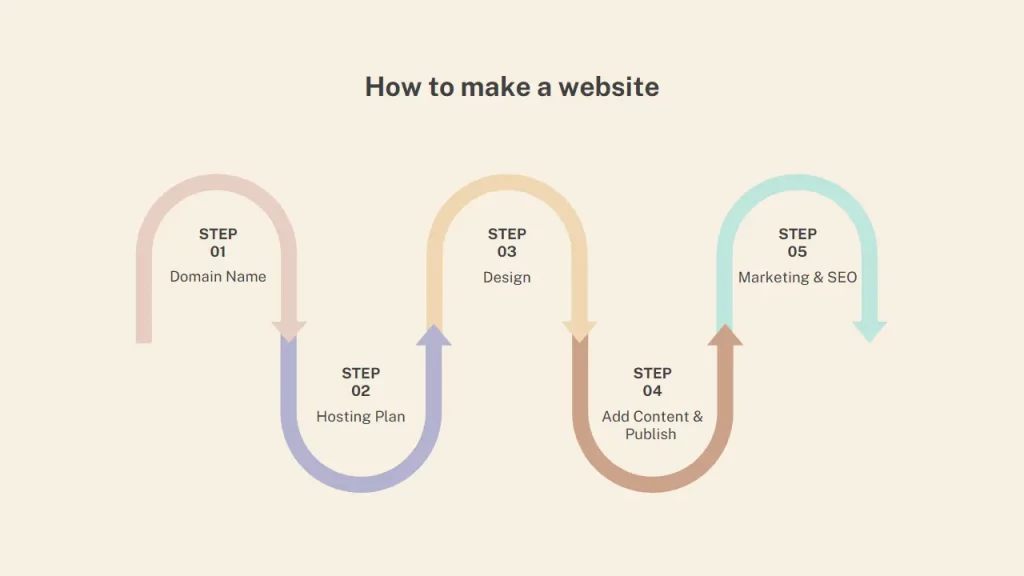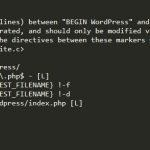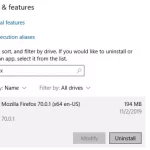You’ve got a great idea for a website and you want to turn it into reality. But where do you start? Making a website can seem daunting, but the truth is that if you break it down into manageable steps, then it’s not so intimidating after all. Here’s an overview of how to make a website from scratch.

Table of Contents
Choose Your Domain Name
The first step in starting a website is choosing a domain name. This can be a daunting task, as there are many things to consider. However, with a little thought and planning, you can find a great domain name that will help your website stand out from the crowd.
First, it’s important to choose a domain name that is relevant to your topic. A good domain name will be easy to remember and help people quickly identify what your website is about. For example, if you are starting a website about gardening, a good domain name might be something like “www.mygardeningtips.com”.
It’s also important to try to get the .com version of your domain name, if possible. While there are other options such as .net or .org, .com is still the most recognized and trusted top-level domain. However, if the .com version of your desired domain name is unavailable, don’t worry – you can still find a great domain name with one of the other options.
Choose Your Web Hosting Plan
When you’re ready to put your website on the internet, you’ll need to find a web hosting plan that’s right for you. There are a variety of different options available, so it’s important to take some time to research your options and decide which one will best meet your needs.
There are a few things to keep in mind when choosing a web hosting plan.
- Consider the amount of space and bandwidth you’ll need. If you have a large website with lots of traffic, you’ll need more space and bandwidth than if you have a small site with only a few visitors.
- Think about what features you need. Some plans offer basic features while others have more advanced options such as email accounts, eCommerce functionality, and more.
- Consider your budget. Hosting plans can range from a few dollars per month to hundreds of dollars, so it’s important to find one that fits within your budget.
- Choose between a hosted vs self-hosted provider. These are 2 categories to consider when it comes to hosting a website. If you are new to web hosting and don’t want to worry about setting up and managing a server, then a hosted plan may be the best choice for you.
Hosted
Both code and data such as content, and images stay on the platform’s own web servers. The providers take the responsibility of managing the source code, data, and server so you don’t have to.
If you aren’t familiar with hosting management, it is better to start off with a hosted platform. After you have more experience or have someone capable of managing a host, you can switch to a self-hosted platform.
- Squarespace – Squarespace comes with hosting, support, and a bunch of features for creative website design. It relies on a drag-and-drop interface – no installation is required. SSL certificates are also offered and no experience is needed to use it – common sense will prevail. The interface is quite straightforward too.
- Shopify – Shopify is one of the main CMS platforms in terms of eCommerce. You have access to all the technical details – from SSL certificates to security and hosting. You also have features such as discounts, inventories, shopping carts, shipping info, and so on – simply put, there is a plugin for every idea you may have.
- Wix – Wix is a professional and fully featured website builder designed for anyone with little to no experience. It is excellent if you have no clue what you are doing, as it handles all the technical data and has a super simple interface. It is mostly suitable for eCommerce websites, but other industries are also supported.
- Weebly – Weebly provides a full solution to cover hosting, website building, and eCommerce scalability. You have email forms, marketing, statistics, and other features for your website or blog. It has both free and premium plans – depending on how sophisticated your website is.
- Blogger – Blogger is a classic and one of the old-school blogging platforms out there. Blogs are hosted over Google’s servers, while the blogspot.com subdomain will give you a bit of search engine optimization. The blog builder is simple and ideal for first-time bloggers.
- GoDaddy Website Builder – GoDaddy has brought in the website builder as a response to the market demand – an intuitive builder for those with no time, money, or experience. You have a mix between a classic CMS and a marketing platform, meaning you have a series of options to advertise for your business as well.
Self-hosted
This is for experienced users. You will buy a hosting service such as shared hosting, cloud hosting, VPS, or a dedicated server from a hosting provider like DigitalOcean, Linode, or SitePoint.
You have more control over your website’s code and data. However, it is also required more maintenance and responsibility.
If you follow this approach, you need to code the site from scratch or use a CMS to start your website.
Some popular CMS web owners choose to make their websites:
- WordPress – WordPress is the leading CMS platform on the market. It is an open-source program – free to use. There are thousands of widgets and plugins to be used, as well as themes – some of them free, others premium. Initially a blogging platform, WordPress is used for sophisticated websites these days. WordPress is used by everything from small businesses to major publications like The Guardian and Forbes.
- Drupal – Drupal is an open-source platform that can be installed on your own server – you will need hosting for it. You get lots of modules, as well as plenty of themes for it. Functionality is flawless and there are many plugins that can provide just the features you want. Drupal is more complex than other similar platforms.
- Joomla – Joomla is a reliable CMS option – free, open source, and easy to install. You have extensions, plugins, and widgets that will make your life easier. However, customizing it is more difficult than other similar platforms. The good news is there are plenty of tutorials out there.
- Progress Sitefinity – Progress Sitefinity may not be as popular as other systems, but it has a simple structure that allows you to choose just the features you need. It is suitable for both professional developers and less experienced users. The website builder is drag and drop and features blocks, features, and plugins to move around.
- More CMS and frameworks for specific type of website:
When deciding which hosting provider to use for your website, think about what kind of site you want and what your budget is. If you want a simple site with just a few pages, Wix or Squarespace might be the best option for you.
If you need a more complex site with eCommerce or lots of content, WordPress would be a better choice. And remember, you can always change your mind later – most platforms make it easy to export your content and switch to another provider if you decide you want something different down the road.
Create Your Website Design
Now that you have your domain name and web hosting plan set up, it’s time to create the design of your website. Depending on your own technical skills and budget, this could be done manually using HTML/CSS or by using a content management system (CMS) like WordPress or Wix.
It’s important that whatever platform you use produces a user-friendly interface so visitors can easily navigate through your site pages.
Designing a good-looking website is not just about aesthetics — it also needs to be functional too! Think about what type of content will appear on each page and how users will interact with the site elements when constructing the design of your website.
For example, if visitors will need to fill out forms or make payments via PayPal then these should be built into the design from the beginning so they don’t experience any problems later down the line.
There are some approaches you can use for your website’s design:
- Use a template: There are a variety of templates available online that you can use for free or for a fee. Templates can be customized to fit your specific needs and can be used for a variety of different types of websites.
- Hire a web designer: A web designer will be able to create a custom design for your website and can also help you with the coding and development of your site. This option can be more expensive than using a template, but it will allow you to have a completely unique website.
- Use an online service: These design services typically provide you with everything you need to create your site, including templates, hosting, and support. They can be more expensive than using a template or hiring a web designer, but they can also save you time and effort in the long run.
- Do it yourself: If you have the time and skills, you can also create your own website design from scratch. This option will give you the most control over the look and feel of your site, but it will also require the most time and effort on your part. If you are not sure where to start, there are a number of resources available online that can help you learn how to create a website design.
Add Content & Publish Your Site
Now that you have designed your website and chosen a color scheme and relevant fonts, it’s time to start adding content! If you already have branding materials such as a business logo, make sure to use the same colors and fonts on your website so everything looks consistent.
As you add text, images, videos, etc. to each page of your website, keep in mind that less is usually more. Use short paragraphs and clear headlines to make your content easy to read and digest.
And before you hit the publish button, be sure to double-check everything! Once your website goes live, you can always go back and make changes if needed. But taking the time to proofread and edit before publishing will save you from having to fix any errors later on.
SEO & Marketing
Once your site has been published, it’s important to start building a presence for your business online by promoting and marketing it. You can do this manually by posting updates on social media or by using other digital marketing tools like email newsletters, paid ads, etc…
And don’t forget about search engine optimization (SEO): this is key if you want to maximize your site’s exposure and attract more visitors. There are many different techniques and strategies you can use to improve your site’s ranking in search results, including using keywords relevant to your business, creating quality content that others will want to link to, and engaging with other websites in your industry or niche.
By investing time and effort into your website’s SEO, you will be able to drive more traffic and get more conversions in the long run.




